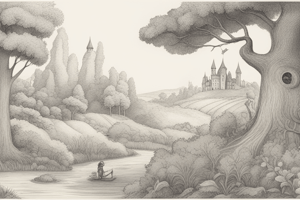Podcast
Questions and Answers
What is the primary function of the respiratory system?
What is the primary function of the respiratory system?
Gaseous exchange between the circulatory system and the atmosphere.
Which of the following structures are part of the upper respiratory system?
Which of the following structures are part of the upper respiratory system?
- Larynx
- Nasal cavity (correct)
- Bronchi
- Trachea
The alveolar sacs are the main sites of gas exchange in the respiratory system.
The alveolar sacs are the main sites of gas exchange in the respiratory system.
True (A)
What are the two main parts of the respiratory system based on function?
What are the two main parts of the respiratory system based on function?
What is internal respiration?
What is internal respiration?
The __________ are hollow organs that allow you to talk and make sounds.
The __________ are hollow organs that allow you to talk and make sounds.
Which statement about the diaphragm is true?
Which statement about the diaphragm is true?
How many lobes are there in the right lung?
How many lobes are there in the right lung?
Which of the following factors can affect the respiratory system?
Which of the following factors can affect the respiratory system?
The tidal volume is the maximum amount of air a person can expel from the lungs.
The tidal volume is the maximum amount of air a person can expel from the lungs.
What is one way to keep the respiratory system healthy?
What is one way to keep the respiratory system healthy?
Flashcards are hidden until you start studying
Study Notes
Definition of the Respiratory System
- Responsible for gas exchange between the circulatory system and atmosphere.
- Comprised of the nose, pharynx, larynx, trachea, bronchi, and lungs.
- Classified structurally into upper (nose, nasal cavity, pharynx) and lower (larynx, trachea, bronchi, lungs) respiratory systems.
- Functionally divided into conducting zone (filters, warms, moisturizes air) and respiratory zone (gas exchange occurring in alveoli).
Functions of the Respiratory System
- Facilitates speech and smell.
- Delivers air at appropriate temperature and humidity levels.
- Supplies oxygen to cells and removes carbon dioxide as waste.
- Protects airways from harmful substances and irritants.
The Breathing Process
- Inhalation starts via the nose/mouth, passing through the trachea and bronchial tubes.
- Bronchial tubes branch into bronchioles leading to alveoli, where gas exchange occurs.
- Approximate 600 million alveoli present, surrounded by capillaries for oxygen transfer into blood.
Internal Respiration
- Refers to the exchange of oxygen and carbon dioxide between blood and tissue cells.
Lung Anatomy
- Lungs divided into lobes: right lung has three lobes; left lung has two lobes.
- Pleurae are thin sacs enclosing each lung lobe, separating them from the chest wall.
Additional Structures
- Cilia are tiny hairs that filter dust and irritants from airways.
- Epiglottis is a tissue flap preventing food or liquid from entering the trachea.
- Larynx (voice box) enables sound production during airflow.
Mechanics of Pulmonary Ventilation
- Lungs expand via diaphragm movement and rib cage elevation.
- Inspiration involves diaphragm contraction, lowering lung surfaces to create negative pressure.
- Expiration occurs when diaphragm relaxes, and lung elasticity compresses air out.
Pleural Pressure
- Pleural pressure is generally slightly negative, facilitating lung expansion.
- Normal pleural pressure at rest is around -5 cm of water, dropping to -7.5 cm during inspiration.
Alveolar Pressure
- Alveolar pressure is equal to atmospheric pressure when glottis is open, allowing airflow.
- For air to flow into the alveoli during inspiration, pressure must fall slightly below atmospheric levels (to -1 cm of water).
Pulmonary Volumes and Capacities
- Tidal Volume: about 500 mL of air per breath.
- Inspiratory Reserve Volume: an additional 3000 mL achievable beyond tidal volume.
- Expiratory Reserve Volume: additional 1100 mL expelled forcefully.
- Residual Volume: remaining 1200 mL post-expiration.
- Pulmonary Capacities: Inspiratory Capacity (~3500 mL), Functional Residual Capacity (~2300 mL), Vital Capacity (~4600 mL), Total Lung Capacity (~5800 mL).
Factors Affecting the Respiratory System
- Surface tension of alveolar fluid, airway resistance, lung compliance.
- Influences include temperature, pain, allergies (dust, mold, pollen), asthma, infections, diseases (lung cancer, COPD), aging, and structural damage.
Gas Diffusion through the Respiratory Membrane
- Respiratory unit includes respiratory bronchiole, alveolar ducts, and alveoli.
- Alveoli have thin walls with nearby capillaries, facilitating gas exchange.
- Respiratory membrane layers include surfactant layer, alveolar epithelium, basement membranes, interstitial space, and capillary endothelial membrane.
Keeping the Respiratory System Healthy
- Avoid pollutants and smoking, eat a nutritious diet rich in fruits and vegetables.
- Stay hydrated, engage in regular exercise, and prevent infections through hand hygiene and annual flu vaccinations.
Studying That Suits You
Use AI to generate personalized quizzes and flashcards to suit your learning preferences.




